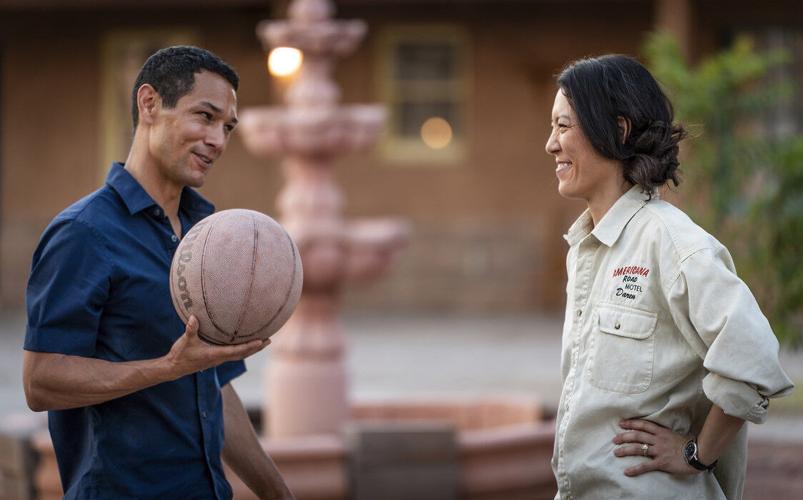Independent films featuring images and voices of diverse cultures from around the world will be the focus of this year’s Arizona International Film Festival.
For the 31st annual event, 30 feature films and 70 shorts from 20 countries will be screened from April 19 to 30 at various venues, including The Screening Room, the Mercado Festival Grounds at the Mercado Annex, the Loft Cinema, Main Gate Plaza, Hotel Congress Plaza and more.
Opening up the festivities will be “The Warm Season” at the Mercado Annex Festival Grounds, 267 S. Avenida del Convento, on April 19 at 7:30 p.m. The sci-fi drama about human-extraterrestrial contact impresses with humor and heart, organizers said. Admission is $10.

“The Warm Season” will open up the 2023 Arizona International Film Festival.
This year there is a strong representation in Native American-directed films, including: “The Nature of Healing,” about the Mohawk Institute, Canada’s first Indian residential school; “Imagining the Indian,” which covers the fight against Native American mascots; and “Gift of Fear,” a coming of age story that revolves around the issue of Missing and Murdered Indigenous Women.
Outdoor screenings at the Mercado Annex will include documentary films about healing combat dogs with PTSD (April 26), a Chinese double-amputee climber who reached the summit of Mount Everest (April 27), and an animated feature from Hungary about an Indigenous creation myth (April 28).
“The festival always produces exciting surprises, challenging subject matter and a bountiful repertoire of films you won’t find anywhere else,” a news release said. “Many of the films screened go on to win prestigious awards, including Oscars and national recognition.”

“Gift of Fear” is a coming of age story that revolves around the issue of Missing and Murdered Indigenous Women.
As part of the film fest, there will be free Zoom panels for filmmakers and the public about making films in Arizona, cinematography, documentary filmmaking, Indigenous filmmaking and Canadian cinema, organizers said.
The event aims to serve as a venue for independent filmmakers searching for an independent audience.
Over the years, the Arizona International Film Festival has shown more than 3,200 films from 100 countries worldwide to more than 172,000 film lovers of all ages.
Single admission tickets are available for $10 through filmfestivalarizona.com. Saver passes, which cover six admissions for $30, are available, as are all-access passes for $100. Saver and all-access passes can only be purchased in person at the Mercado Annex box office on April 19 from 6 to 8 p.m. and The Screening Room box office, 127 E. Congress, starting April 20 from 6 to 9 p.m.
For a full list of films, locations and panels, visit filmfestivalarizona.com.
If youre going to make a blockbuster you need some deep pockets. But how did we get to todays multi-million-dollar movie budgets? Hollywood wasnt always a high-rollers club. In 1913, Universal produced "Traffic In Souls" for $5,700. But as the industry expanded, so did costs. In Joel Finlers book "The Hollywood Story" he charts the rise. By 1920, a feature film cost an average of $60,000 to produce. That swelled to $375,000 by 1930. Part of the reason for rising costs was demand for high quality content, according to former TV network executive Tom Nunan. Nunan is the former president of NBC studios and UPN, professor at UCLA school of theater, film and television and producer of Oscar-winning film "Crash.""The American standard of filmmaking and creating content is the gold standard still around the world. So, when our budgets are going up, the money is generally going on the screen," he said. MGM paid more than $2.7 million to make "The Wizard of Oz" in 1939 its most expensive production at the time. And that was more than a decade before the average cost for a feature film topped one million dollars. By the 1970s, multi-million-dollar productions were commonplace, sparked by inflation and a new group of producers and directors looking to take Hollywood to new heights. Steven Spielbergs "Jaws" and George Lucas' "Star Wars" cost $7 and $11 million, respectively, and set the stage for studios to push the envelope with special effects. "Studios are having to go overboard coming up with ideas and directors and technology that will pay off to make these movie-going experiences worth the hassle of going out to movie theater," Nunan said. SEE MORE: 2023 Academy Award nominations are full of record-breakers, milestonesAnd that effort is because its getting harder to attract viewers. Movie theater attendance is dropping, a trend which actually started before the pandemic. To win over audiences, Nunan says studios are changing the way they think about productions. "In the 20th century, where we basically were watching movies that were character driven, that were based on movie stars and what their character was going through," he said. "And when we moved into the late 20th century, into the 21st century, the concept of the movie became the movie star. And the way that concept was executed in ways that no one could have ever imagined. The biggest change has been the introduction of the superhero tent-pole movie, where audiences expect spectacular special effects and action sequences." More recent movies like "Spider-man 3,""Justice League," and "Avengers: Endgame" each cost hundreds of millions of dollars due to hefty checks for stars and money for special effects. "The talent costs are the largest what we would call line item on a budget. And right below that would be on a kind of a graduated basis, special effects, visual effects, action sequences," Nunan said. And even though some big-budget movies dont pay off, it remains to be seen if the industry will tighten its belt. "The only evidence we have is that movies are getting bigger and more expensive. And I don't see that going away anytime soon," Nunan continued.Meaning that blockbuster movies could continue to have blockbuster price tags.







